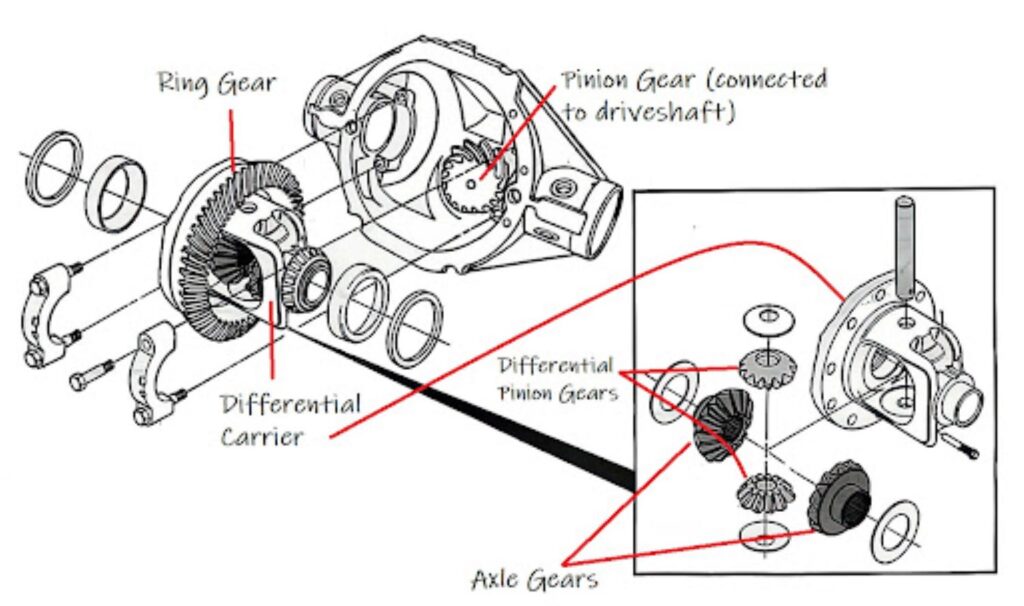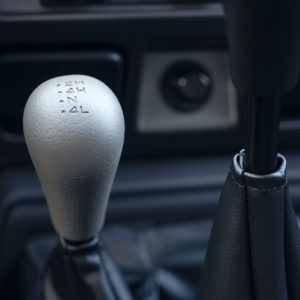If the differential starts leaking differential fluid, you should take action immediately and identify what’s causing the leak before things get worse.
What is a Differential?
The rear axle of a rear wheel drive vehicle is typically referred to as the “differential.” The rear axle receives the turning torque from the transmission via the driveshaft, which is connected to the steel pinion gear shaft in the rear axle housing. On the opposite (back) end of that pinion shaft is a cone shaped gear.

The pinion gear shaft and its gear are all one piece of steel. The shaft spins in two opposing tapered roller bearings and transmits the turning torque to the ring gear.
As with all tapered roller bearings, these must have a specific amount of “preload,” meaning, they need to be tight against their respective races but not too tight. These are vaguely similar to the front wheel bearings on older vehicles, but the preload is more important on this set of pinion bearings.
The ring gear usually has about 3 times as many teeth as the pinion for torque multiplication and is bolted to a cast iron differential carrier, which contains a smaller set of gears known as differential gears or spider gears.
Two of these gears are larger and are each connected to an axle. The other two smaller gears rotate on a polished shaft connected at both ends to the ring gear carrier cage to form a moveable connection between the two rear axle gears. This arrangement enables the outer wheel on a turn to spin faster than the inner wheel. When the vehicle is driving straight, these gears are static, meaning that while they’re rotating with the carrier, they aren’t rotating against each other.
What Is a Rear Differential Leak?
A rear differential leak is an issue where differential oil seeps out of the rear differential’s housing. This happens when one of the mechanical seals in the differential has worn out or failed. The differential gasket, pinion seals, and side seals are some of the seals that can leak differential fluid if they go bad. They are made of rubber and can degrade over the years.
That’s not to say, however, that they always will. Some vehicles never have a differential leak and wind up going to the salvage yard with the same oil in the differential housing that was put there on the assembly line.
Most OEMs don’t require differential oil changes. The differential can leak at the axles, the pinion seal, the differential gear cover, or through a damaged differential housing.

Differential seals can leak due to internal pressure if the axle vent is clogged. Sometimes merely unclogging the axle vent will cause the seals to stop leaking, but if they are leaking even for that reason, it’s a good idea to replace the seals. But make sure you know how to do it right. If you don’t, then hire it done by a reputable shop.
Bad Rear Differential Leak Symptoms
Here are some of the most common symptoms of a rear differential leak that you should keep an eye out for:

Differential fluid on your vehicle’s underside
There is no light on the dash to tell you when the differential is low on oil, so have a look under there and see if you notice a leak. If you check the differential housing and find differential fluid or traces of the lubricant, you likely have a rear differential leak.
When a seal in the diff gets worn out or damaged after thousands of miles of use, oil can find its way through the failing part. In sufficient amounts, the leaking lubricant can leave distinct traces on the bottom of your vehicle.
In general, differential fluid seeping out of the diff won’t make your vehicle unsafe to drive in an emergency. However, the seemingly minor problem can develop into a full-blown leak if you do not tend to it in time.
Differential fluid pooling on the ground
Not all of the differential fluid that seeps or drips out of the diff remains on its housing. The leaking oil can end up on the ground surface. A major rear differential leak can deposit oil spots underneath your vehicle. Usually, these sizable leaks will also leave a considerable amount of differential fluid on the bottom of the differential.
If you find oil on the under chassis and on the ground, you should take a look at the rear differential and have it fixed immediately.
Strange noises from the differential
If the rear differential leak goes unattended long enough or becomes severe, you might hear clicking, clunking, howling, or whining noises. Those noises are made by unlubricated gears as they mesh together. They are a sign that the leak has depleted the differential oil inside the diff.
The differential oil prevents direct contact between the gears and also lubricates the bearings. Insufficiently lubricated gears will wear out rapidly.
Why Is a Rear Differential Leak Bad For Your Vehicle?
Also referred to as the “final drive unit,” the rear differential carries heavy loads as it alters where the applied engine torque goes. It directs torque to go through the axle shafts and drive wheels. The differential and the transmission gear ratios working together is how the engine can move a vehicle that weighs thousands of pounds. The engine alone can’t do this.
How to Avoid Rear Differential Leaks
The only thing you can do is keep the differential vent clear of clogging and don’t drive through deep mud. Most manufacturers don’t list differential service as part of scheduled maintenance.
Keep an eye out for vibrations in the driveline. Check the various parts for any signs of damage. If one of the driveline parts has an issue, repair or replace it immediately.
Do you push your vehicle hard on a regular basis? Hard acceleration pulling heavy loads is hard on the gears, particularly the small ones in the differential carrier. By reducing the workload of the rear differential, you can extend the service life of its parts.

How to Fix a Rear Differential Leak
Once you confirm there is a leak in the rear differential, you should resolve the issue as soon as possible. However, once the oil has leaked out and the damage is done, expect the cost of repair to be significant.
To fix the issue, you must first identify the part of the rear differential that developed a leak. Potential culprits for the problem include the differential gasket, pinion seals, and side seals. You should also inspect and test the differential cover, rear differential tube, differential vent tube, and the axle seals.
Once you’ve found the faulty part, replace it immediately. Keep in mind that you might have to partially disassemble the differential before you can access the problematic part.
Tracking down the exact part responsible for the rear differential leak can take time and requires considerable knowledge of auto repair. If you are not confident in your ability to perform DIY car repair, it’s a good idea to bring your vehicle to a trusted auto service center.
How Much Does a Replacement Differential Gasket Cost?
A faulty differential gasket is one of the leading causes of rear differential leaks. This gasket seals the diff and keeps the oil inside.
A replacement gasket, if you decide to use one instead of RTV (most shops use RTV) can go for anywhere between $5 and $85. Factors like your vehicle’s details and the part’s manufacturer can affect the price of a new gasket.
Getting a Long-Lasting Replacement Rear Differential For Your Car
A leaky rear differential will cause transmission issues ranging from poor handling on the road to premature tire wear. You should replace the faulty part as early as possible before it causes more serious problems in your transmission. Make CarParts.com your one-stop shop for new parts like rear differentials.
Here at CarParts.com, we give you comprehensive information about product fit, making buying rear differentials and other parts for your vehicle simpler and easier. Our strategically located warehouses ensure you can receive your order in as fast as two business days.
Why delay replacing a leaky rear differential when it’s so easy to order a replacement here at CarParts.com? Check out our selection of quality rear differentials and shop now.
Any information provided on this Website is for informational purposes only and is not intended to replace consultation with a professional mechanic. The accuracy and timeliness of the information may change from the time of publication.
































Much appreciated; thank you for the thorough and helpful information, Richard!